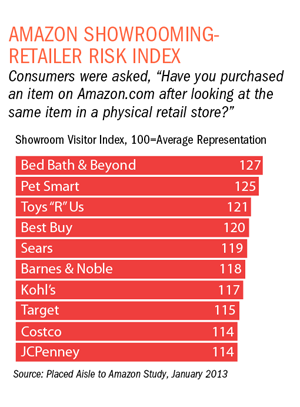Best Buy and Target, two brick-and-mortar retailers identified in a recent study as being at high risk of losing sales to showrooming, have adopted the same solution. They are both offering customers a price-match guarantee.
Certainly, for consumers, showrooming is a godsend in this era of renewed frugality. But price matching may be an inadequate response by Best Buy and Target, according to David Shim, founder and CEO of Placed, a mobile analytics company that conducted the study.
Companies go to great pains to establish product markups justifying specific profit margin objectives. Once everyone is aware that prices can be instantly lowered for goods at Target, Best Buy and other retailers, margins will become slimmer and slimmer. The question then becomes: Who’s really running the store—the retailers or the e-tailers?
“Price matching could backfire,” said Shim. “If you train the customer to scan every product’s price because they know the store will match the lowest one charged, the financial impact becomes more and more problematic.”

It becomes a game of “how low can you go,” he explains. “Brick-and-mortar retailers can’t match Amazon’s margins when they have salespeople on the floor and big premises,” said Shim. “This is a very reactionary way to handle the risk.”
Interestingly, Best Buy and Target are not the retailers at highest risk of showrooming, according to the Placed study, Aisle to Amazon, which draws wide-ranging data from a panel of 14,000 mobile phone users. This dubious distinction, in order of ranking, went to Bed Bath & Beyond, PetSmart and Toys “R” Us. Others on the “high-risk” list include Sears, Barnes & Noble, Kohl’s, Costco and JC Penney.
While these traditional retailers are vulnerable to showrooming risks, Shim concedes the financial impact is small relative to these companies’ overall business volume. “It’s impacting their bottom line, but not to a point where it is really significant—not yet,” he said. “As the trend of showrooming increases, they may enter the problem zone. Frankly, retailers that match the prices of online e-tailers virtually guarantee this. The more consumers that ask for a price match, the greater the margin shrinkage.”
Competition is sure to heat up in the aftermath of the showrooming price wars. Best Buy, for example, not only will lower prices against 19 online competitors, it will also reportedly match advertised prices from brick-and-mortar competitors.
Target, which tested an online price match policy this past holiday season, decided to extend it year round. It will even match the online price on an item previously purchased. Just bring in “an original Target receipt and proof of a current price to Guest Services,” said Target spokesperson Eddie Baeb in an email.
Costco, on the other hand, has no intention of entering the price-matching fray. “We stand by our commitment to pre-select items of great quality and then mark them up as little as possible,” said Costco CFO Richard Galanti. “People come to our stores for all sorts of product purchases, from electronics to gas to fresh foods, knowing our mark-up, on average, is 11%.” According to Galanti, that compares to supermarkets in the mid-20s, Home Depot and Lowe’s in the low- to mid-30s, and 50% to 200% markups at department stores.
Asked if potentially lower prices on items such as televisions from Amazon or another e-tailer are having an impact on sales, Galanti says “not in the least.” Costco’s TV sales are “up from the mid-to-high single digits in the last nine months.”
He adds, “I don’t want to sound like we’re putting our heads in the sand, but I just don’t think [showrooming] is as big an issue for us as it is for others.”
Given their decision to match online prices, Best Buy and Target evidently believe this issue is significant for them. Are the big box stores rushing toward an obvious, albeit financially risky, solution? Shim thinks so. He suggests retailers go on the offensive rather than become reactionary. “Enhance customer service, provide customer loyalty programs, offer discounts for volume buys and provide other value-adds that won’t have as much impact on the bottom line as price matching,” he said. “There is more than price to empower consumers to make the best decisions.”
